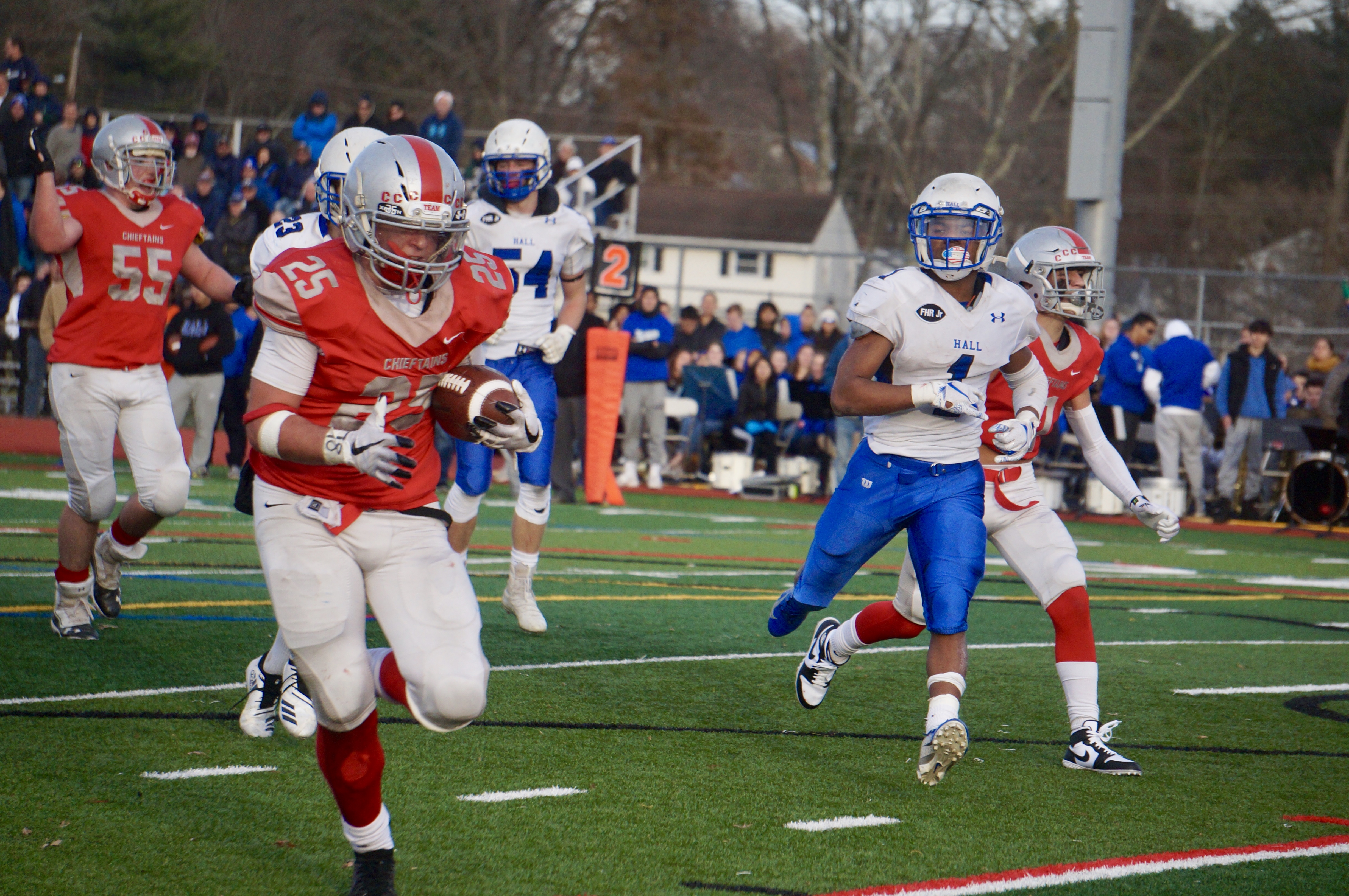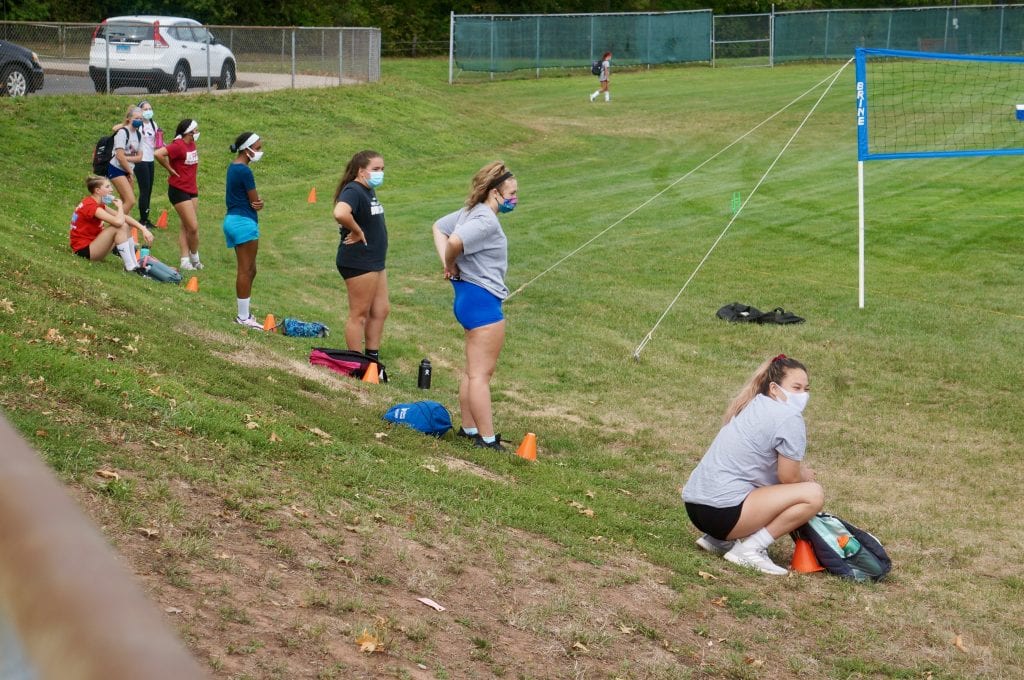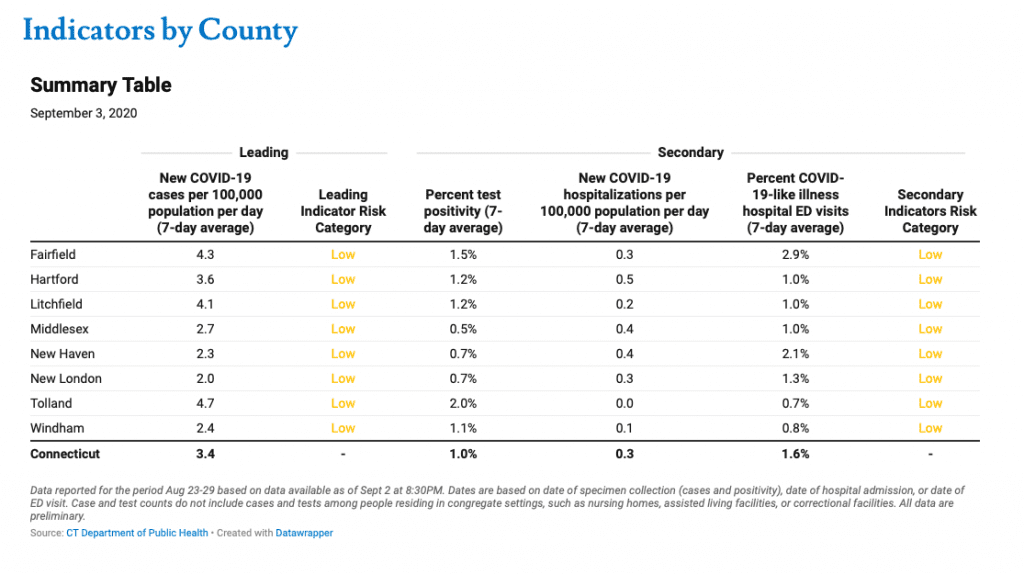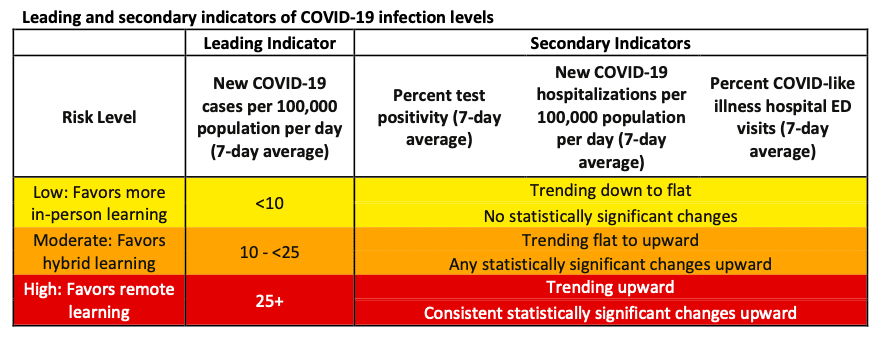As Fall High School Football Season Scuttled, West Hartford Teams Continue Workouts

Audio By Carbonatix

Annual Conard vs. Hall West Hartford Mayor’s Cup football game. Nov. 23, 2019. Photo credit: Ronni Newton (we-ha.com file photo)
The CIAC announced Friday that a ‘full contact season’ will not take place for football in the fall of 2020, but believes that by wearing masks for indoor games, volleyball can continue.
By Ronni Newton
The Connecticut Interscholastic Athletic Conference (CIAC) officially cut the slim threads of hope that football players and coaches had left for an 11 vs. 11 season of full contact play with the announcement Friday that, due to a lack of support from the state Department of Public Health (DPH), the fall football season will not move forward.
“Without DPH support, the CIAC cannot move forward with a full contact season as it would place superintendents and boards of education in the impossible position of acting against the recommendation of a state agency,” the CIAC said in an announcement Friday.
While the decision was a disappointment to many, it was not unexpected since the DPH has maintained its position over the past several weeks that it does not support higher-risk sports such as full contact football and indoor volleyball.
“As we have stated previously and consistently, there are characteristics that make certain sports unique with regard to their potential for the spread of COVID-19, and thereby present a higher risk for initiating or furthering community spread of any outbreaks even when data metrics support in-person learning,” Deidre Gifford, acting commissioner of DPH, wrote in a Sept. 3 letter to the CIAC.
“I don’t know that I am entirely surprised with the decision,” West Hartford Athletic Director Jason Siegal said Friday afternoon. “I don’t think the coaches were surprised either.”
Hall head football coach Frank Robinson and Conard head coach Matt Cersosimo notified players of their respective teams as soon as the decision was announced.
“The seniors are obviously really bummed, disappointed,” Siegal said. But they still consider themselves teams, and are excited to get together for their workouts, he added.
Siegal said that the CIAC’s football committee is already engaged in conversations about how to provide some type of meaningful football experience for the students, perhaps 7 vs. 7 non-contact play, combine activities, or a combination. There had been previous talk about moving football to the spring, which the CIAC had said it did not support, and Siegal said he doesn’t know if that idea might be revisited.
He said that he, and West Hartford Superintendent of Schools Tom Moore, will be following the guidance of the state Department of Public Health as well as the local West Hartford-Bloomfield Health District.
“If we can explore those possible football experiences for our players, then we will have those discussions,” Siegal said.
Pushing higher risk sports into 2021 is an approach that some other states are taking. Massachusetts Interscholastic Athletic Association (MIAA), according to massive.com approved a “floating fall season” to take place between February and April 2021, during which higher risk sports like football will be played.
Siegal said that Friday afternoon practices were planned for all sports as originally scheduled.
After a pause in mid-August, the CIAC announced Aug. 30 that practices for all fall sports could resume on Aug. 31.
Currently, all sports are limited to one-hour practices in 10-person cohorts, with activities including only conditioning or sport-specific non-contact drills. Many teams planned Saturday practices as well, with most will be off for the rest of the Labor Day holiday weekend.
The volleyball teams at both Conard and Hall have been practicing exclusively outdoors, Siegal said. Conard’s team has taken over left field of the baseball field and Hall’s team is practicing at Eisenhower Park.
He said he does not believe the guidance is completely clear about how the volleyball season can progress.

Volleyball team members, spaced by cones, wait for practice to begin. Nets have been set up on Conard’s baseball field so practice can be held outside. Photo credit: Ronni Newton (we-ha.com file photo)
“We will see if DPH clearly supports indoors with masks,” Siegal said. “As a school system, we are taking our guidance based on DPH recommendations.”
The CIAC, in Friday’s announcement, stated that it believes that having volleyball players wear masks for indoor play would allow the sport to be played this fall.
“In alignment with DPH’s recommendation to consult its sports medicine committee, the CIAC and its medical experts believe that the modification of wearing masks mitigates the risk expressed by DPH and provides a safe indoor environment for the sport of volleyball,” the organization stated Friday. “As such, with the modification of players wearing masks indoors, the CIAC has aligned volleyball with DPH’s previous support of full team practice and game schedules for soccer, field hockey, cross country, and swimming.”
In her Sept. 3 letter, Gifford said DPH would “continue to encourage such modifications” to higher risk activities, but also noted, “We would also recommend that CIAC consult with your sports medicine committee before implementing significant changes to how high school sports are played in our state so that any potential unintended consequences of those changes (including increased risk of injury) can be fully vetted prior to implementation.”
High school football athletes, and many coaches, expressed their disappointment – and anger – regarding the decision. Many took to Twitter to express their sentiments.
Speaker of the House Joe Aresimowicz, who is also the head coach of the Berlin High School football team, tweeted the following message Saturday afternoon.
Important message from CT Speaker of the House and Berlin High Head Football Coach Joe Aresimowicz https://t.co/gH76MX7qHC pic.twitter.com/dlc9XA9DaX
— CIAC Sports (@ciacsports) September 5, 2020
Jack Cote, a senior at Hall High School, wrote the following Op-Ed regarding the impact of the decision on the mental health of student athletes.
There’s a petition on Change.org, started by a player at Haddam-Killingworth High School, that as of 5 p.m. Saturday had more than 29,000 signatures formally requesting the CIAC and DPH to allow 11 vs. 11 football. The petition questions why, despite the COVID-19 metrics in Connecticut being among the best in the country, the state cannot join the other 35 states that will be play football this fall.
In West Hartford, Siegal said thus far there have not been any requests from football athletes at either school to switch to another sport for the fall season. “If we can do that safely, we will handle it on a case-by-case basis,” he said.
Siegal is excited about the return of students to their classrooms on Sept. 8. “Tuesday is going to be a fun day,” he said. “The students are excited to get back.”
Sports practices will continue after school, as they have for the past week, and he confirmed that students who are on an “off” week are still able to practice, with the cohorts designed by coaches to the extent possible so that Red Team and Blue Team students are kept separate.
While there are not many who have signed up, full time remote learning students have been given the opportunity to participate in sports, Siegal said.
“At the end of the day, we want kids to be able to participate in interscholastic athletics as much as possible,” Siegal said. He said the number one goal, however, is for the students to have a safe experience attending school.
DPH will continue to publish reports on and each Thursday sends an enhanced report to school districts with metrics that provide advice regarding the leading and secondary indicators, on a county-by-county basis, that are being used by DPH and the Department of Education to determine whether learning can take place in person or should switch to remote. Advice regarding sports also takes into account the metrics.

Screenshot

CIAC handout
While as of Sept. 3, all indicators were in the “low” category, “it is important to consider the direction of trends in those metrics as well and unfortunately, we are already seeing some of the metrics in our state trending upward,” Gifford said.
“DPH follows local and national trends and meets regularly with other states and federal partners as well as the Centers for Disease Control and Prevention. All of these activities form the basis of our public health recommendations.”
Like what you see here? Click here to subscribe to We-Ha’s newsletter so you’ll always be in the know about what’s happening in West Hartford! Click the blue button below to become a supporter of We-Ha.com and our efforts to continue producing quality journalism.




[…] participants were protesting the decision announced Friday by the Connecticut Interscholastic Athletic Conference (CIAC) announcing that full-contact 11-on-11 football will not be played at Connecticut high schools this […]
[…] football players had been left in limbo throughout the summer, the initial announcement, released on Sept. 4, was met with disappointment as well as anger by some in the football community. In response, more […]